
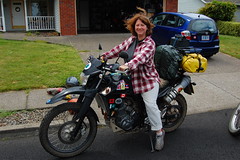
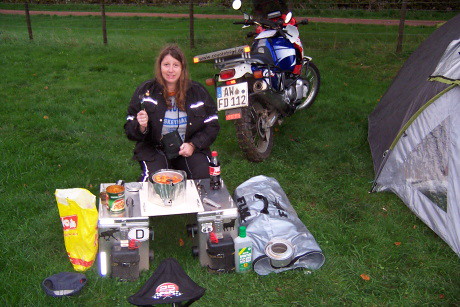

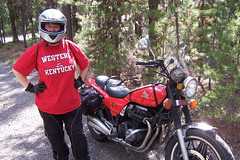
Coyotebroad's Advice for Women
Motorcycle Travelers
(especially those who camp):
Packing
disclaimer
Whether you are packing for a one week trip or for a six month
trip on a motorcycle, you pretty much pack the same things!
What you pack on your motorcycle has a lot to do with whether
or not you will be tent camping, staying in yurts and primitive
cabins, etc., as opposed to staying in motels and hotels.
The former is cheaper, but you have to take more stuff (like
your sleeping bag).
What you pack also has a lot to do with how often you will be
eating food someone else prepares (eating in restaurants and
roadside stands once a day? twice a day? every meal?) versus
what you are going to prepare yourself at your campsite. The
more you are going to eat at restaurants or convenience stores,
the less you have to take.
In the vast majority of places you go, even most developing
countries, you can buy what you absolutely need if you
forgot to bring it. In the USA, a convenience store in really
remote areas may, in fact, have a dusty old tent on a back shelf
amid newer items.
I have a reason for every item I've listed below. When I try to
do without one of these items on a trip, I end up regretting it.
I reconsider this list only immediately after a trip, NEVER
while packing.
Some general packing tips:
- Budget space in your luggage for things you want to buy to
use on the road (wine, beer, food, maps, brochures) or to have
for after the trip (jewelry, a shirt, a wee knickknack, etc.).
- Put identification in every bag or pannier on your
bike, and every satchel or purse within such. Include
your name, email address, phone number and city and state. You
may want to put the address of somewhere you are staying.
- For clothes, other than motorcycle gear, go for durability
and practicality. I think loose-fitting clothes are best as
well.
- Don't take electronics, jewelry or other valuables that you
would be heartbroken to lose or that are easily broken.
- Regarding medicine: some things are easy to get anywhere,
even other countries, like aspirin, but other things aren't,
like prescription treatments for a yeast infection or any
asthma medications/inhalers. If you take prescription meds,
have documentation affirming you have a prescription for such
medication, even if you are traveling domestically. If you are
taking prescription pain killers and they are not in their
original bottles with your name and official prescription on
them, this is especially important.
- My list is my list. It will be different than
yours. Every person packs differently, both in what they bring
and how they pack it, and you will discover what's best for
you through trial and error. Don't let anyone shame you
regarding what you bring ("I can't believe you brought
THAT."). The only person who decides what you need is YOU.
Luggage / Where things will go
All space in your luggage and on your person (in your pockets,
in a purse, etc.) is at a premium when traveling by motorcycle.
You need to budget space and plan for where you will put each
item EVERY time (this will help you find stuff).
In addition to packing things in the panniers or saddle bags,
you may also have a bag that lays on the back of your back seat,
secured to your panniers (where a passenger could sit on
other occasions) and you may also have a top box. Some people
also have a tank bag.
Some take a backpack and wear it while on the motorcycle, but I
really caution you against that - you want to be super
comfortable on your motorcycle. Instead, pack a small backpack
or purse you can pack in your panniers or attach very securely
to your luggage outside (and in that case, it needs to be
waterproof), and remove that and carry it around when you need
to carry things while shopping, touring a site as a pedestrian,
hiking, etc.
How we do it when we were two-up on one motorcycle: one
pannier on my husband's bike was filled with all of my personal
items (clothes, toiletries), as well as our medicines. The other
pannier was for all of his clothes and personal items. All food
related items went on one long bag strapped to the back of a bike,
all sleeping items and the tent (and the stools, if we bring them)
and a jug of water went in ANOTHER long bag strapped to the first
one. His top box was for bike maintenance tools and our rain gear.
Water bottles were on either side of the gas tank, strapped to the
crash bars. I also had my purse with items we needed easy access
too (snacks, drinks, field glasses, etc.). He carried a camera on
his handlebar bag. Here is what it all looked like packed when we
are two-up on his bike, and unpacked when we camped:

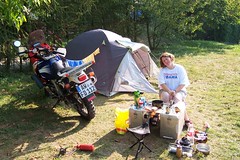
Now that we both ride our own motorcycles, we distribute
everything much more. We really don't take much more than we did
previously. We both have panniers, top boxes, tank bags and
handlebar bags. And we still carry our water bottles as we did
before (on his bike). Below are photos of me, first on my Honda
Night Hawk with cloth panniers and a bag strapped on the seat, and
now on my KLR with aluminum panniers.

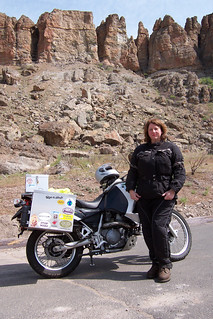
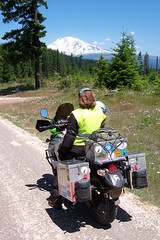
The list below is based on what I pack for a two-week or more trip
on my own motorcycle.
What I pack or wear on a
motorcycle trip where I will tent camp:
Motorcycle gear
- helmet
- either my winter or summer mesh motorcycle jacket. My winter
jacket has lots of pockets, and removable lining - I rarely wear
my lining, but if it's going to be especially cold on the trip,
I have to budget room for it to pack when I'm not wearing it on
a trip. My mesh jacket needs more pockets!
- motorcycle pants. They came with removable lining but I never
wear my lining because, quite frankly, I've been too fat, and I
find a pair of long underwear under them is enough when it's
cold, and I don't want to give up any more room in my cases for
the lining.
- summer gloves
- winter gloves (yes, both. I've ridden in 100 plus weather in
the day and it's been below freezing)
- motorcycle rain jacket. It fit over my motorcycle jacket.
Also great for wearing when we're taking a break from riding on
a trip and walking around in the rain in regular clothes. I
always have this in my top box.
- motorcycle rain pants. They fit over my motorcycle pants;
mine are way bigger than needed, but it makes them easier to get
on and off. I always have this in my top box
- boots I not only ride in, but I
can also hike in. I do quite a bit of walking on motorcycle
trips, sometimes hiking up to four miles in a day.
- rain covers for the boots. I always have these in my top box.
Boots do NOT dry overnight.
Clothes and cloth for personal use (as opposed to use by
anyone else traveling with me)
- camper's towel,
the kind that's much smaller and thinner than a regular bath
towel, but that is much more absorbent and dries more quickly.
- a small regular towel (a bit bigger than a hand
towel). You will be stunned at how often you need to use such on
a trip -- because the hotel's towels are unusable, because you
don't have a pillow, because you need to clean up something..
this is not a towel I would be broken-hearted about having to
leave somewhere or throw away.
- sink stopper, for washing things in a sink, maybe even taking
a bath. Even most luxury hotels often have sinks or tubs that
don't hold water well. The best sink stopper is just a
flat piece of round, thick plastic that lays over any kind of
drain. I bought mine at a grocery store.
- a "wax," also known as a sarong or sarung. It's a large piece
of thin, usually colorful, cloth that is often worn by women in
developing countries as a wrap-around skirt or very large shawl.
You can do the same, or use it for a top sheet when your
sleeping bag or the European-style comforter is too much on a
warm night, as a head scarf (often needed to tour a mosque or
ultra-conservative Catholic church or an Eastern Orthodox
Church), extra covering as a shawl or skirt in conservative
countries, a picnic blanket... You can buy them at any
hippy/dippy store, any import store and the like. They pack very
small -- I can easily fit one into my purse pack WITH other
stuff. If you're going to be taking a particularly long trip,
take two (so you can use them both at the same time - skirt and
shawl, skirt and headscarf, etc.). Wash them in cold water, to
see if they shrink (you don't want to take one that shrinks!).
An alternative: an airplane blanket (yes, the kind you get on an
airplane - just fold yours in your purse before deplaning).
- multi-functional scarf headband, one of those long, seamless
tubular things you can wear in different ways (a headband, a
bandana, a beanie, a pirate-style cap, a neck scarf, neck
gaiter, etc.). It's also great for bad hair days (which, for
most women motorcycle riders, is EVERY DAY - at least that's how
I feel) and when you are in a religiously-conservative country
where you must cover all of your hair (put on the headband so
that it covers your hair all around your face, then put your wax
over your head as a head scarf - voila, you're culturally
sensitive!). I wear mine as a neck scarf while riding.
- In this era of global pandemics, you need to bring a mask,
one that has a nose piece that you can adjust to fit snugly over
your nose and that fits relatively snugly against your cheek and
under your chin. I use the Outdoor
Research Face Mask. It comes with a removable inner
filter, I can wash it, it's black (doesn't show dirt) and it
folds well. You can use your headband around your mouth for more
protection. A lot of travelers got stuck abroad when the novel
coronavirus broke out without one (including
me).
- thin hiking pants, about one size too big for me. You are not
going to wear your motorcycle riding pants ALL the time when not
riding, especially when you have to get up in the night to go to
the bathroom at a camp site or when it's really hot. I have two
100% nylon pairs that are water resistant (lots of wet picnic
benches out there), very easy to wipe off dirt, easy to wash in
a sink and quick-to-dry, super comfortable, lightweight for hot
temps, easy to wear over long underwear for colder temps, easy
to sleep in if needed, and can be converted into shorts. I take
just one pair on a trip.
- up to four t-shirts. I don't change t-shirts every day of a
motorcycle trip. I prefer gray shirts, especially if they have
logos on them - hides stains better & stays cool in hot
weather. White shirts are THE WORST (they are filthy in 5
minutes). Black shirts and dark colors heat up in the sun. Don't
take shirts that you will brokenhearted if they get stained or
torn, or shirts that you aren't for sure if they shrink in a
wash.
- one long-sleeve t-shirt for a trip less than two weeks; two
for a trip two weeks or more. I take shirts that are lightweight
and big enough to be worn over long underwear or even together
at the same time, if the weather calls for such. I sometimes
also wear a short-sleeved t-shirt over a long-sleeve shirt.
- one pairs of long-underwear, top and bottom. Wearing
long-underwear, plus my pants and a long-sleeve shirt, are often
all I need to keep warm around a camp site and in my sleeping
bag for the night, as long as it's not going to get near or
below freezing. Also, I rarely bring the lining in my motorcycle
pants or jacket, because I find them too bulky; long-underwear
packs smaller and is more comfortable to wear. I hate two pair
of bottoms if I'm going to be gone longer than two weeks.
- long sleeved, sheer, thin insulayer. I call it my "second
skin". If I wear this under a regular long-sleeved shirt, it's
like wearing a sweatshirt or sweater in terms of warmth. If I
wear it underneath a sweatshirt or sweater, particularly along
with a long sleeved shirt or long-underwear, it's like wearing a
winter coat! Mine is 100% polyester, but if you have the money,
try silk. Very easy to rinse out. One of the very best purchases
I have ever made!
- one sweatshirt/sweater/pull over if I know there's going to
be below freezing temps. A long sleeve shirt, long-underwear and
insulayer, all combined, keep me warm in freezing temps while
riding, without my jacket liners. A sweatshirt/sweater/pull over
is for while at the camp site or hiking rather than under my
bike jacket while riding.
- two bras. I prefer highly-durable athletic bras for
motorcycle traveling that are easy to wash and dry. Dark colors
only!
- panties. How many? I used to take six-seven pair of cotton
briefs - dark colors - and do my best to wash and dry, as
needed, for a trip more than a week. I made the switch to
ExOfficio briefs, because they dry much, much more quickly than
cotton after washing (in one night), they are more durable than
cotton, and they pack smaller. I take just three pair, and wash
the one or two dirty pairs every other night (cold water only!).
Buy one pair before a trip and wear it to make sure it's right
for you. And dark colors only!
- disposable panty liners. At least five, more if I have room.
When you can't shower at least every two days, you will be really
glad you brought these.
- feminine hygiene products (thin underwear pads or tampons)
for THAT time of the month (be sure to budget room for such if
I'm going to buy such on the road instead of packing right from
the get go)
- at least one pair of thin socks or footies, one pair of light
hiking socks, and one pair of thick winter socks. I take a
second pair of one of these categories of socks as well,
depending on the weather I expect on the trip.
- Teva sandals. I only have these and my motorcycle boots on a
trip. Sometimes I take super cheap, ultra thin flip flops for
showers. I wear my sandals around the campsite, for going out to
dinner at night, maybe even small hikes. If it's cold, I just
wear thick socks with them and hope for the best.
- Here's specific advice regarding
footwear (shoes & socks) for women motorcycle travelers.
- Bathing suit. Every time I don't take a bathing suit, I regret
it. I think, oh, we're not going to be near water, I won't pack
it - and we end up right at a lake. I think, oh, it's too cold
to swim - and we end up at a motel one night with a heated pool.
If you use such just once on a trip, it's worth the room
it takes to pack!
Optional:
- I have some vanity clothes. I might take a long-sleeve button
down shirt, one that I can hike in, that is big enough that I
could wear long underwear underneath, that is easy to wash, and
that might look halfway decent when worn with my hiking pants or
my wax as a skirt, that might make me feel presentable in, say,
a really nice restaurant. Lately, I've been taking a light
weight dress I bought from the UNICEF market
place. It's multi-colored (handles stains well) and is
easy to hand wash. I wear it most often when we stay in a hotel
instead of camping. It's also great to wear over a bathing
suit.
- I sometimes take a sock cap/tuque/touque - but only if I know
it will be really, really cold. I particularly need this for
sleeping on a really cold night, but it also is nice to wear
while cooking or around camp on a cold night or morning (in
addition to keeping me warm, it also hides my hair).
- Shower sandals. Just a cheap, small, durable pair of flip
flops, if I think I will be showering in grimy camp site
showers.
- Maybe a second pair of hiking pants - really only if a trip
is going to be longer than a month and I think I might not be
able to replace or repair a pair that rips during a trip. Same
rules as the others: super light weight, can be converted into
shorts.
- Non-riding gloves for warmth, if I will be in freezing temps
at night while camping. I sleep in these if it's freezing or
below.
Sleeping:
- tent. If it's just you and no one else, get a
two-person tent, so you have plenty of room for your luggage and
motorcycle gear, and plenty of room to read, sew or whatever on
a rainy day. If you are going to share the tent with one other
person, get a three-person tent, so you have plenty of room for
gear. Get a tent with a large vestibule, so you can store stinky
boots outside of the tent but not without some cover, for items
you want off the bike but not in the tent, etc. If you are
traveling with someone else that isn't your romantic partner,
you each might want to take your own two-person tent, so you can
each have privacy at night. Be sure you put up your tent in your
back yard at least once, and get inside it, and get in and out
of it, before you pack it up and take it on a trip. It's hard to
find tents that have a separate rain fly (which you will not
want on hot nights) and that provide privacy when the rain fly
isn't on (everything is sheer now), but if you find such, buy
it!
- sleeping bag. Get one that can handle below-freezing
temps. If you end up in a climate that's too hot for such a bag,
use your wax/sarong or bring an airplane blanket to use as a top
sheet and then you lay on top of the bag. My sleeping bag is
more than 25 years old (from REI) - and I love it... but it's
lost its ability to handle below-freezing temps, so I also take
a sleeping bag liner - a sleep sack - that makes me warmer in
the bag. The sleep sack packs very small and I've been really
pleased with it.
- a Therma-rest, or similar, highly-durable air mattress.
Go ahead, call me a wimp. Say it: Wasted space! I don't
care. My Therma-rest keeps me off the cold, hard ground. Mine is
more than 25 years ago, and is slightly longer than my body. I'm
comfortable all through the night and oh-so-happy each morning,
ready to enjoy the day because I've had plenty of sleep. I think
you should do whatever it takes to have a great sleep -
that's essential to enjoying yours trip and being well rested so
you can be sharp during your ride. After you buy your air
mattress, test it at least once: blow it up and make sure it
holds its air overnight, and when you lay on it for a while.
Between trips, air mattresses are best stored blown up,
actually.
- high quality inflatable pillow. Go ahead, again, call
me a wimp again. Say it: Wasted space! Use your clothes as a
pillow! Shut up! I need a real pillow! I love being happy
throughout the day because of my oh-so-comfortable night's
sleep. Plus, before I started taking Prilosec, I suffered from
severe acid reflux/heartburn, and even with medication, I need
to sleep with my upper body well-elevated, so I stack up my bike
pants, I blow up my pillow and put it on top, and I am a happy
girl all through the night (and then the following day as
well!).
- earplugs. Two pairs. Don't wear them in bear country
or if you are scared of other campers! I actually hate wearing
these, because I want to be able to hear something approaching
the tent. But people that camp are getting worse and worse about
noise at night - playing music, talking loudly, etc. I never
wear them rough camping but usually do in a full camp ground if
everyone seems relatively cool.
- eye cover. You get these free on international
airplane rides. Great if you need to take a power nap in the day
time (and if you need a power nap, TAKE IT - stay sharp on your
motorcycle!). Packs so small, you will forget you have it.
Toiletries for just myself
- shampoo. Enough not just for my hair, but to wash my
underwear as well, as needed
- conditioner. Because of the nature of my hair, it's
essential
- body soap. I still prefer hard soap (this will need a
hard container) to liquid soap.
- tooth paste
- tooth brush (and something to keep the brush clean
while packed)
- tooth floss (you may need it for more than teeth -
it's a great thing to tie things with. I've used it to hang
clothes before!)
- any special moisturizer you, personally, need, as
opposed to the moisturizer listed elsewhere that is going to be
shared among everyone on the trip
- small box or small bag of laundry detergent for a washing
machine, if the trip will be longer than two weeks and I
need to wash t-shirts and hiking pants (although most laundry
mats and gas station convenience stores are going to have small
boxes you can buy, with coins)
- comb or brush
- lip balm (with sunscreen) or lip stick
- baby powder (no, it does NOT cause cancer - stupid
juries)
- a container/bag for all toiletries to take to the
bathroom (I not only have a little mesh bag I bought at REI for
toiletries, I put that little bag, along with my towel and
whatever else I think I need, like shower flip flops, in a
large, tough plastic bag or nylon that's easy to schlep to and
from the bathroom at a camp site or hostel)
- small loofa pad to scrub the face daily (maybe even
take another for the body, or one just for your feet)
Practical items I will share with those I'm traveling with
(meaning these are taken, but may be on someone else's bike, or
I may pack enough for more than just me)
- tweezers
- fingernail clippers (or small scissors)
- small packet of tissue (put this in your motorcycle jacket or
pants, for use in bathrooms with no toilet paper)
- a first aid kit
- candle lantern
- small tarp (you may need this to create a shelter to cook
under, or you may need it if your sleeping bag floor rips and
can't be repaired or turns out not to be water proof)
- four clothes pins
- rope, long enough and strong enough for hanging clothes
(we've dried clothes with a line tied between the handlebars of
our two bikes)
- matches (keep in something waterproof)
- heartburn prevention pills
- anti-acid tabs
- Advil
- aspirin
- Tylenol (yes, I take all three kinds of pain relievers)
- hand sanitizer
- Neosporin (or anything similar)
- modium
- hand wipes
- moisturizer
- sunscreen
- mosquito repellent
- allergy medicine
- prescription meds (inhaler for asthma, for instance.
Antibiotics for water-borne or air-born illnesses and
antibiotics for urinary tract infections are especially
important on really, really long trips.)
- bandaids/bandages
- moleskin (for blisters)
- a tiny bottle of glass cleaner (for cleaning everyone's
visors)
- some paper towels (for cleaning everyone's visors, for
cleaning things that cannot be cleaned by cloth, etc.)
- some duct tape
- repair kit for air mattress and tent
- sewing kit
- one-two plastic document sleeves, for essential documents
that should not ever get wet
Other essential items
- Brake disk wheel lock. I have such with me for ALL
motorcycle trips, and use it any time I am going to park my
motorcycle out of my site for longer than 15 minutes. I'm not
kidding - I live in the Portland, Oregon area and the entire
Pacific Northwest is the WORST when it comes to motorcycle
theft. Viking Bags regularly
has clearance
sales and these often include bike locks.
- Field glasses - binoculars (I regret it every time I
don't take these)
- Cell phone or smart phone and charger for
such (a charger that works from your bike is terrific)
- Camera and case (you want to pack the camera in
such a way that it's super-quickly accessible during a ride)
- Head lamp (one that has different settings is best
- this will be your flashlight as well)
- Batteries for all electronics
- Swiss army knife (have your own personal one -
don't keep asking to borrow someone else's)
- Two writing pens
- Journal. I like a Moleskine calendar book, because
it's thicker than any journal I can find, it has an elastic
band to keep the book closed, and the pages are lined. I keep
it in a clear, plastic bag used for veggies at a grocery
store.
- A book to read. Not just for bed time, but for when
you are stuck somewhere because of weather or a break down.
- One cloth or nylon bag, with straps, that folds
down quite small. Good for grocery shopping, as these are easy
to strap on your back, even while wearing another back pack.
- Small, clear plastic bags (the kind of flimsy
things used for veggies at grocery stores). I use one to wrap
my journal in, one to wrap whatever book or magazine I'm
reading in, one for essential documents (copies of health
insurance, motorcycle insurance, etc.), one for maps not
currently in use), one for brochures I may gather as the trip
goes on... in short, I wrap anything individually I'm putting
in my backpack or in any non-rainproof luggage that could be
ruined by getting wet. I take a few extra as well (and almost
always end up using every one of them, for garbage bags if
nothing else).
- Four-five, semi-durable, not-clear plastic bags.
The thick ones you get in clothing stores and bookstores are
best. I use one for my Teva sandals, one for my shower sandals
(if they are wet), one for my mesh bags that hold my bathroom
necessities, one for dirty laundry, and an extra or two for
other needs that arise on the road.
- Small plastic grocery bags. I put our
on-the-road/day food in one, use another, or others, for foods
that should be kept dry (even if food will be in panniers, you
will be so glad you put such in a plastic bag), use another to
carry our recyclables from tent to bin (a growing number of
camp sites recycle), and use whatever is extra for trash or
needs that arise on the road. You will get these on the road
as you buy food at groceries, but remember that you will start
accumulating trash almost immediately on a trip, and may not
have a place to throw away something if you don't take an
extra plastic bag.
- my own, personal water bottle (packed or carried in such a
way for immediate access during breaks from riding)
- birth control (condoms may not be readily available
everywhere - and in some countries, it wouldn't be appropriate
for you, a woman, to buy such)
- backpack, to wear while riding, hiking, etc. Great place
for items you need immediate access to during the day
(medicine, water bottle, etc.)
- paper copies of health insurance and motorcycle insurance
information (also have copies on your phone and somewhere on
the Internet you can download from)
I've decided to put my packing list for
food/meals, cooking, snacking and cleanup while on a
motorcycle camping trip on a separate page.
Optional
- a collapsible sitting stool/camping chair; not needed if you
are going to camp in established campgrounds in the USA and
Canada, where there are always picnic tables at camp sites (and,
therefore, plenty of places to sit) or if you aren't going to
camp rough. Also not needed by my husband and me anymore,
because our panniers, together, can form a small table and two
very low seats. He
sells these panniers, by the way. And here's how fabulous they look as a table and chairs.
- a small lunch bag from a camping store designed to keep cold
items cold, without ice, for a few hours (lunch meat, eggs,
maybe even three or four beers!)
- as mentioned earlier, my husband has managed to strap a small
hard-sided cooler bag to the top of his panniers for some trips,
and it has been a heavenly thing to have - we buy ice each
evening before we stop to camp for the night and any other
groceries we need, and then in the morning, I have milk, we have
eggs, the lunch meat isn't spoiled... it's awesome!
- some aluminum foil (for cooking potatoes on a fire)
- business cards
- selfie stick
- playing cards (good for rainy days when you can't do anything
or if your motorcycle ends up in a shop)
- portable backgammon board (it rolls up to the size of a selfie
stick in fully collapsed form - again, great for rainy days when
you can't do anything or if your motorcycle ends up in a shop)
- address list (to send postcards and for emergencies; have it
printed out and on your phone)
- tiny speakers (and charger for such) and enough music on your
phone to enjoy on a trip (and not listen to exactly the same
songs every night); but please do NOT play music in camp sites
during quiet hours!
- guidebook, or a series of pages you've put together based on
your pre-trip planning and research (hotel names, directions to
obscure places, etc.); keep it in something semi-waterproof, and
have a version on your phone
- foreign phrase book
- Something like Point
it: Traveller's Language Kit - The Original Picture Dictionary,
a no-words book. We have the Langenscheidt OhneWörterBuch.
500 Zeigebilder für Weltenbummler - without words book -
published by Langenscheidt, but it's not available in the USA.
- GPS
- Spot Tracker or similar device (we like to mark ourselves
safe at every camp site and every vista point, then we get home,
we have a series of satellite marks for where we've been on our
trip, emailed to us each time)
- If there is any chance we'll stay in a hotel or motel,
I take a portable smoke and carbon monoxide detector and I also
take a door stopper.
And, of course, for the motorcycle itself:
- some motor oil
- extra gas (we have highly durable gas containers attached to
the back of our panniers; these containers are for sale from coyotetrips)
- tools for the bike (beyond what may be in the bike's
maintenance kit)
- spray-on chain oil
Below is a pack list from
Eric and Gail Laws, legendary motorcycle
travelers who lived in Westfir, Oregon. Eric and Gail road two-up
on their motorcycles on every continent, including across Russia
in 1992, which earned them
a place in the Guinness Book of World Records
as the first people to cross Russia by motorcycle, a 6,998 mile
trip from Magadan to Moscow. Talk to enough motorcycle world
travelers and, eventually, you meet people who knew Eric and Gail
- including Stefan, who met them in a small town near the Meteora
Monasteries in Greece in 2006. Many of those motorcycle travelers
eventually found themselves at Eric and Gail's hidden homestead in
Oregon to stay a night or two on their way from Canada to Mexico,
or midway through a grand tour of the USA. In addition, every
summer, Eric and Gail opened their river-side estate to
international motorcyclists and those interested in such, for a
small, low-key gathering, more camping soirée than rally... except
for the burning of the motorcyclist effigy. They called it
Burning Moto Man, and no other motorcycle
event has been as good, IMO - it was warm, friendly and fun,
without all the posing and macho crap of other rallies.
Eric passed away on May 4, 2013 due to
cancer. Eric and Gail started a web site to help adventure
motorcycle travelers, named for their beloved, and now deceased,
dog, Tynda. It was a hot mess in terms of design... and it's long
gone from the Interwebs. But in writing an article about them, I
pulled off this sage advice:
IF YOU THOUGHT RIDING YOUR MOTORCYCLE IN SOME OF THE
COUNTRIES MENTIONED HEREIN IS DANGEROUS, WAIT UNTIL YOU
GET OFF.
Yeah, that's Eric - loved his sense of humor. Here are Eric's
recommendations regarding some items to take on long trips:
#1 Snap lock for keys.
Ever get on your motorcycle and realize that your keys were
still in your pocket. Especially, under the rain gear. How
many times does it take. Use a snap lock and snap them to your
jacket zipper. Keeps you from feeling foolish..
#2 Small knife.
Place it on your key chain and snap lock.
#3 Ear Plugs.
If you don't know why you should use ear plugs, it is too
late. But often in foreign countries they play loud music all
night in the campgrounds or there may be a bar/disco close by.
#4 Small Flashlight
In your pocket or on your key chain for emergency or tent use.
#5 Surgical gloves
Even if the foreign doctor has them, they come in handy for
those dirty jobs you do, such as when sewing up wounds.
#6 Face mask & mud flaps
Some riders have complained to us of the dust in South
America, Russia and other countries. Helpful if dust bothers
you while riding alone or behind others.
#7 Candle
Helpful to take moisture out of tents or for those hotels that
have limited electrical hours. Scented candles help in the
unventilated rooms.
#8 Bungle cords
The very small kind have many uses, especially to strap on
items at the last minute.
#9 needles (syringes)
The doctor may not have fresh ones and may want to reuse old
ones.
#10 Business cards
Convey info quickly on that rainy, windy road when you meet a
traveller coming from the other way. Use email and have it on
your card. This is the year 2000, after all.
A little larger items are:
#1 Photo album
Can't speak the language, even so, it shows where you live and
your family, pets, etc.
#2 Motorcycle cover
Hides your motorcycle, and can be used as your ground cover,
raincover, etc.
#3 Small dictionary
After you use it give it away as a gift. English/Spanish or
whatever.
#4 Hand soap & handiwipes
You are not as clean as you think and do you think they have
soap in that toilet or kitchen.
#5 Sheep skin
Can be used on your seat for those long journeys and if big
enough underneath your sleeping bag. Remove the sheep before
using, unless going to a cold climate.
#6 Water pump
Water is the liquid of germs. Beer and bottled water are not
always available.
#7 Siphon Hose
Has many uses especially when you run out of gas.
A good twitter account to follow on the subject of packing for
travel abroad: DepartSmartOrg.
And now a word from my husband:
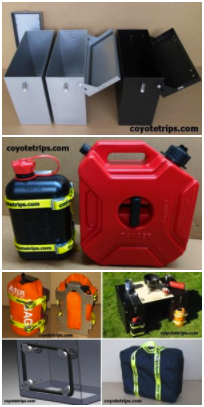
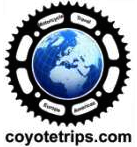
Adventure Motorcycle
Luggage & Accessories
www.coyotetrips.com
Aluminum Panniers and Top Cases,
Top Case Adapter Plates,
Tough Motorcycle Fuel Containers, & More
Designed or Curated by an experienced adventure motorcycle
world traveler
Based in Oregon
You won't find these exact products anywhere else;
these are available only from Coyotetrips
(my husband)
Disclaimer
Any activity incurs risk. The author assumes no responsibility for
the use of information contained within this document.
Comments are welcomed, and motivate me to
keep writing -- without comments, I start to think I'm talking to
cyberair.
 Quick Links
Quick Links 
about Jayne Cravens
contact me
 Follow
me! @jayne_a_broad
(coyotebroad)
Follow
me! @jayne_a_broad
(coyotebroad)
My tweets are about travel, motorcycling, camping, bicycling (as a
commuter), politics and things I find amusing. Eric Idol has replied
to me twice. No, really!
 become
Coyote Broad's fan on Facebook
become
Coyote Broad's fan on Facebook
Posts are only about travel, hiking and camping
Getting Started as a Motorcycle Rider: My
Journey (Tips for Women Who Want To Ride)
My Travel Maps
Coyotebroad
in Germany | in Afghanistan
| in Ukraine
Coyotebroad
adventures in Europe, Africa, as well as road trips in the USA
women
travelers: general information and advice (especially for women
novice travelers, NOT geared towards just motorcycle riders)
Saving Money for
Travel (or to pay off your debt)
transire
benefaciendo: "to travel along while doing good." advice for those
wanting to make their travel more than sight-seeing and shopping.
Permission is
granted to copy, present and/or distribute a limited amount of
material from my web site without charge
if the information is kept intact and is credited to Jayne
Cravens.
Please contact me for permission to
reprint, present or distribute these materials.
The art work and material on
this site was created and is copyrighted 1996-2019
by Jayne Cravens, all rights reserved
(unless noted otherwise, or the art comes from a link to another web
site).














